Evidence-Based Nursing: Pneumonia Pathophysiology, Care and Guidelines
VerifiedAdded on 2023/06/13
|6
|1167
|145
Report
AI Summary
This report provides an overview of pneumonia from an evidence-based nursing perspective. It begins by defining pneumonia as a lung infection causing inflammation and airway obstruction, highlighting its common causes, symptoms, and diagnostic methods. The report emphasizes the importance of understanding pneumonia due to its high global prevalence and mortality rates, particularly among children. It also discusses the relevance of pneumonia to nursing, focusing on patient well-being and mortality risks. The report outlines best practice guidelines for pneumonia care, including improving airway clearance and gas exchange, assessing fluid volume deficit and nutritional needs, and managing pain and infection. The report concludes by referencing several research articles that support the best practice guidelines outlined.
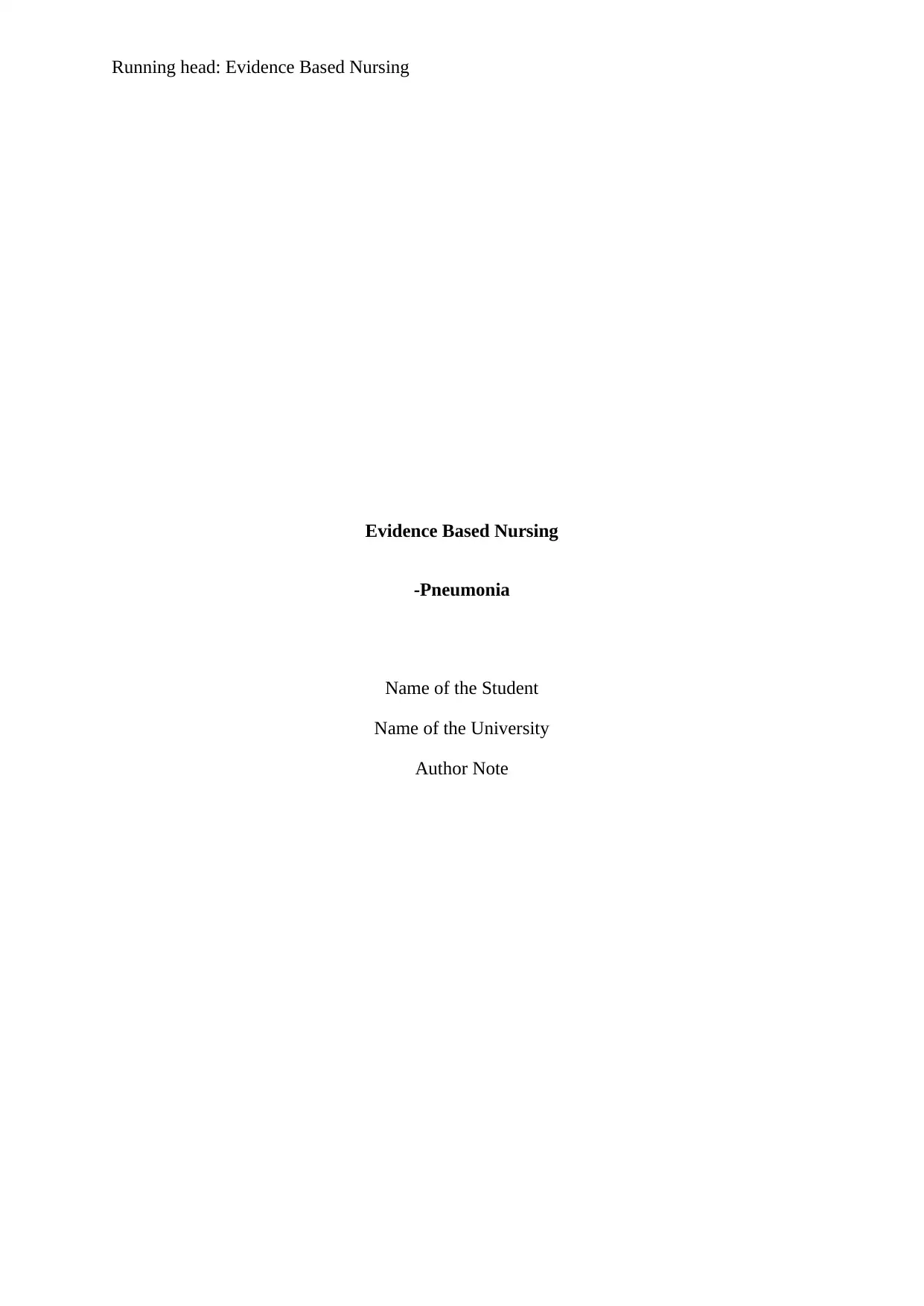
Running head: Evidence Based Nursing
Evidence Based Nursing
-Pneumonia
Name of the Student
Name of the University
Author Note
Evidence Based Nursing
-Pneumonia
Name of the Student
Name of the University
Author Note
Paraphrase This Document
Need a fresh take? Get an instant paraphrase of this document with our AI Paraphraser
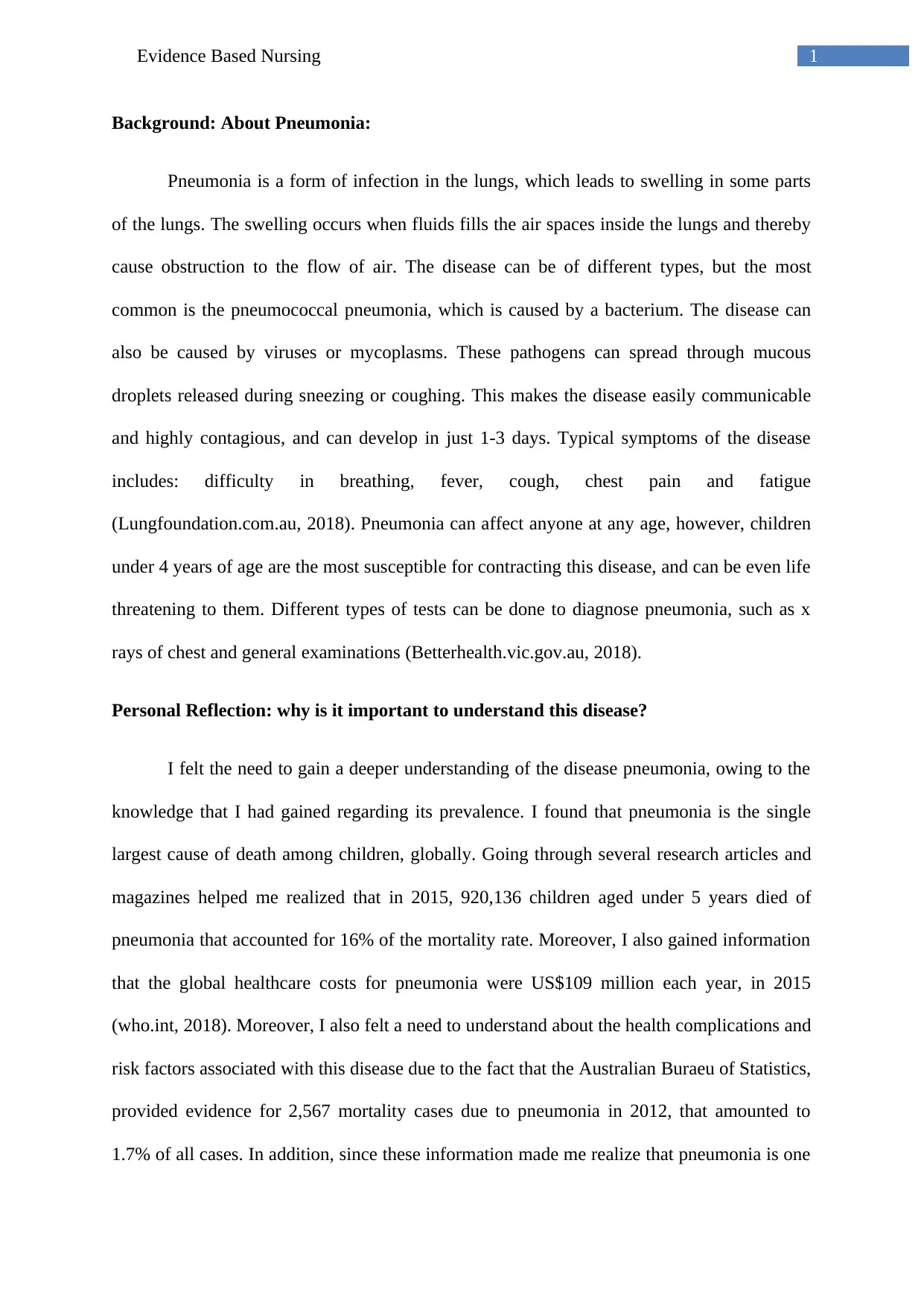
1Evidence Based Nursing
Background: About Pneumonia:
Pneumonia is a form of infection in the lungs, which leads to swelling in some parts
of the lungs. The swelling occurs when fluids fills the air spaces inside the lungs and thereby
cause obstruction to the flow of air. The disease can be of different types, but the most
common is the pneumococcal pneumonia, which is caused by a bacterium. The disease can
also be caused by viruses or mycoplasms. These pathogens can spread through mucous
droplets released during sneezing or coughing. This makes the disease easily communicable
and highly contagious, and can develop in just 1-3 days. Typical symptoms of the disease
includes: difficulty in breathing, fever, cough, chest pain and fatigue
(Lungfoundation.com.au, 2018). Pneumonia can affect anyone at any age, however, children
under 4 years of age are the most susceptible for contracting this disease, and can be even life
threatening to them. Different types of tests can be done to diagnose pneumonia, such as x
rays of chest and general examinations (Betterhealth.vic.gov.au, 2018).
Personal Reflection: why is it important to understand this disease?
I felt the need to gain a deeper understanding of the disease pneumonia, owing to the
knowledge that I had gained regarding its prevalence. I found that pneumonia is the single
largest cause of death among children, globally. Going through several research articles and
magazines helped me realized that in 2015, 920,136 children aged under 5 years died of
pneumonia that accounted for 16% of the mortality rate. Moreover, I also gained information
that the global healthcare costs for pneumonia were US$109 million each year, in 2015
(who.int, 2018). Moreover, I also felt a need to understand about the health complications and
risk factors associated with this disease due to the fact that the Australian Buraeu of Statistics,
provided evidence for 2,567 mortality cases due to pneumonia in 2012, that amounted to
1.7% of all cases. In addition, since these information made me realize that pneumonia is one
Background: About Pneumonia:
Pneumonia is a form of infection in the lungs, which leads to swelling in some parts
of the lungs. The swelling occurs when fluids fills the air spaces inside the lungs and thereby
cause obstruction to the flow of air. The disease can be of different types, but the most
common is the pneumococcal pneumonia, which is caused by a bacterium. The disease can
also be caused by viruses or mycoplasms. These pathogens can spread through mucous
droplets released during sneezing or coughing. This makes the disease easily communicable
and highly contagious, and can develop in just 1-3 days. Typical symptoms of the disease
includes: difficulty in breathing, fever, cough, chest pain and fatigue
(Lungfoundation.com.au, 2018). Pneumonia can affect anyone at any age, however, children
under 4 years of age are the most susceptible for contracting this disease, and can be even life
threatening to them. Different types of tests can be done to diagnose pneumonia, such as x
rays of chest and general examinations (Betterhealth.vic.gov.au, 2018).
Personal Reflection: why is it important to understand this disease?
I felt the need to gain a deeper understanding of the disease pneumonia, owing to the
knowledge that I had gained regarding its prevalence. I found that pneumonia is the single
largest cause of death among children, globally. Going through several research articles and
magazines helped me realized that in 2015, 920,136 children aged under 5 years died of
pneumonia that accounted for 16% of the mortality rate. Moreover, I also gained information
that the global healthcare costs for pneumonia were US$109 million each year, in 2015
(who.int, 2018). Moreover, I also felt a need to understand about the health complications and
risk factors associated with this disease due to the fact that the Australian Buraeu of Statistics,
provided evidence for 2,567 mortality cases due to pneumonia in 2012, that amounted to
1.7% of all cases. In addition, since these information made me realize that pneumonia is one
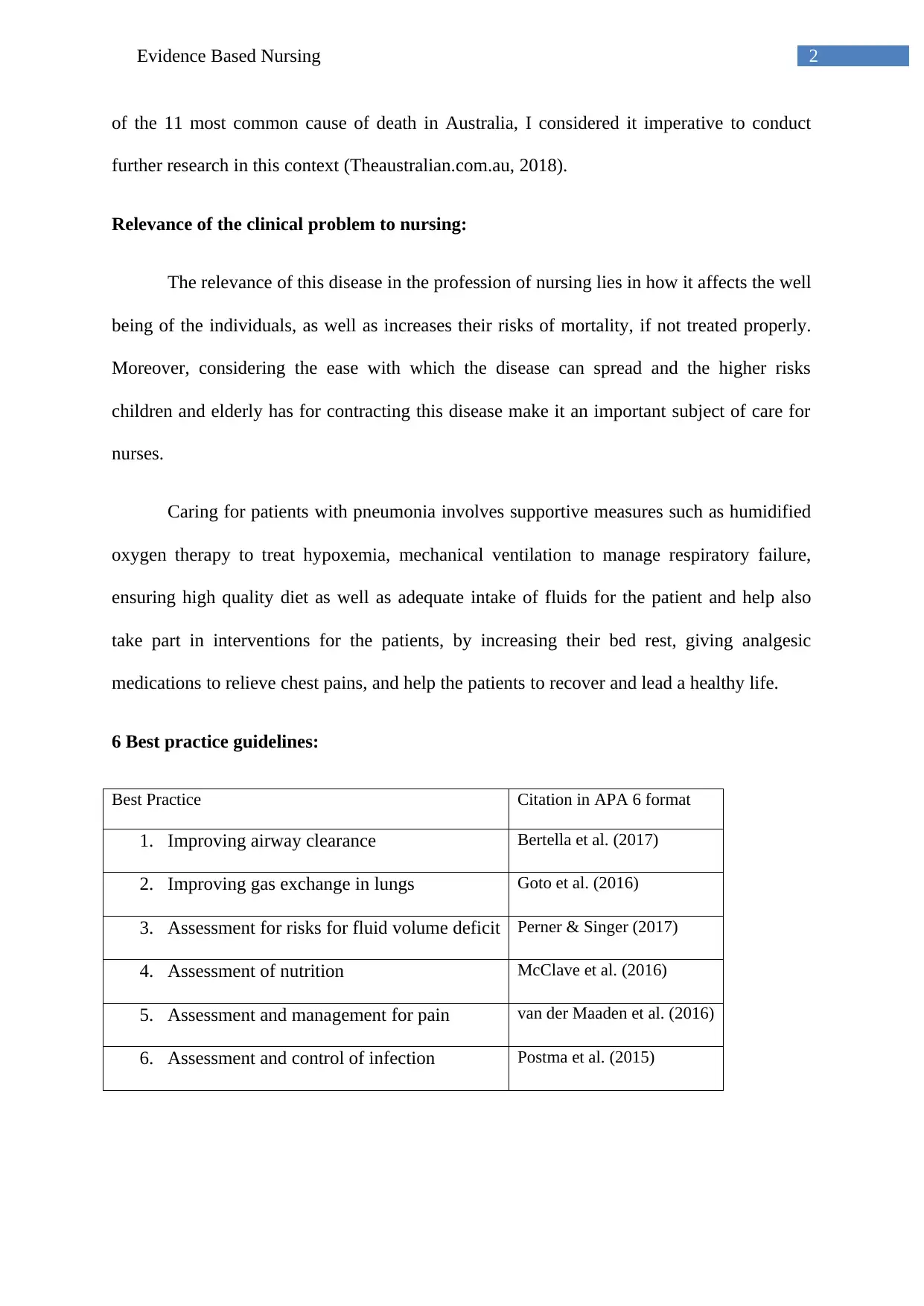
2Evidence Based Nursing
of the 11 most common cause of death in Australia, I considered it imperative to conduct
further research in this context (Theaustralian.com.au, 2018).
Relevance of the clinical problem to nursing:
The relevance of this disease in the profession of nursing lies in how it affects the well
being of the individuals, as well as increases their risks of mortality, if not treated properly.
Moreover, considering the ease with which the disease can spread and the higher risks
children and elderly has for contracting this disease make it an important subject of care for
nurses.
Caring for patients with pneumonia involves supportive measures such as humidified
oxygen therapy to treat hypoxemia, mechanical ventilation to manage respiratory failure,
ensuring high quality diet as well as adequate intake of fluids for the patient and help also
take part in interventions for the patients, by increasing their bed rest, giving analgesic
medications to relieve chest pains, and help the patients to recover and lead a healthy life.
6 Best practice guidelines:
Best Practice Citation in APA 6 format
1. Improving airway clearance Bertella et al. (2017)
2. Improving gas exchange in lungs Goto et al. (2016)
3. Assessment for risks for fluid volume deficit Perner & Singer (2017)
4. Assessment of nutrition McClave et al. (2016)
5. Assessment and management for pain van der Maaden et al. (2016)
6. Assessment and control of infection Postma et al. (2015)
of the 11 most common cause of death in Australia, I considered it imperative to conduct
further research in this context (Theaustralian.com.au, 2018).
Relevance of the clinical problem to nursing:
The relevance of this disease in the profession of nursing lies in how it affects the well
being of the individuals, as well as increases their risks of mortality, if not treated properly.
Moreover, considering the ease with which the disease can spread and the higher risks
children and elderly has for contracting this disease make it an important subject of care for
nurses.
Caring for patients with pneumonia involves supportive measures such as humidified
oxygen therapy to treat hypoxemia, mechanical ventilation to manage respiratory failure,
ensuring high quality diet as well as adequate intake of fluids for the patient and help also
take part in interventions for the patients, by increasing their bed rest, giving analgesic
medications to relieve chest pains, and help the patients to recover and lead a healthy life.
6 Best practice guidelines:
Best Practice Citation in APA 6 format
1. Improving airway clearance Bertella et al. (2017)
2. Improving gas exchange in lungs Goto et al. (2016)
3. Assessment for risks for fluid volume deficit Perner & Singer (2017)
4. Assessment of nutrition McClave et al. (2016)
5. Assessment and management for pain van der Maaden et al. (2016)
6. Assessment and control of infection Postma et al. (2015)
⊘ This is a preview!⊘
Do you want full access?
Subscribe today to unlock all pages.

Trusted by 1+ million students worldwide
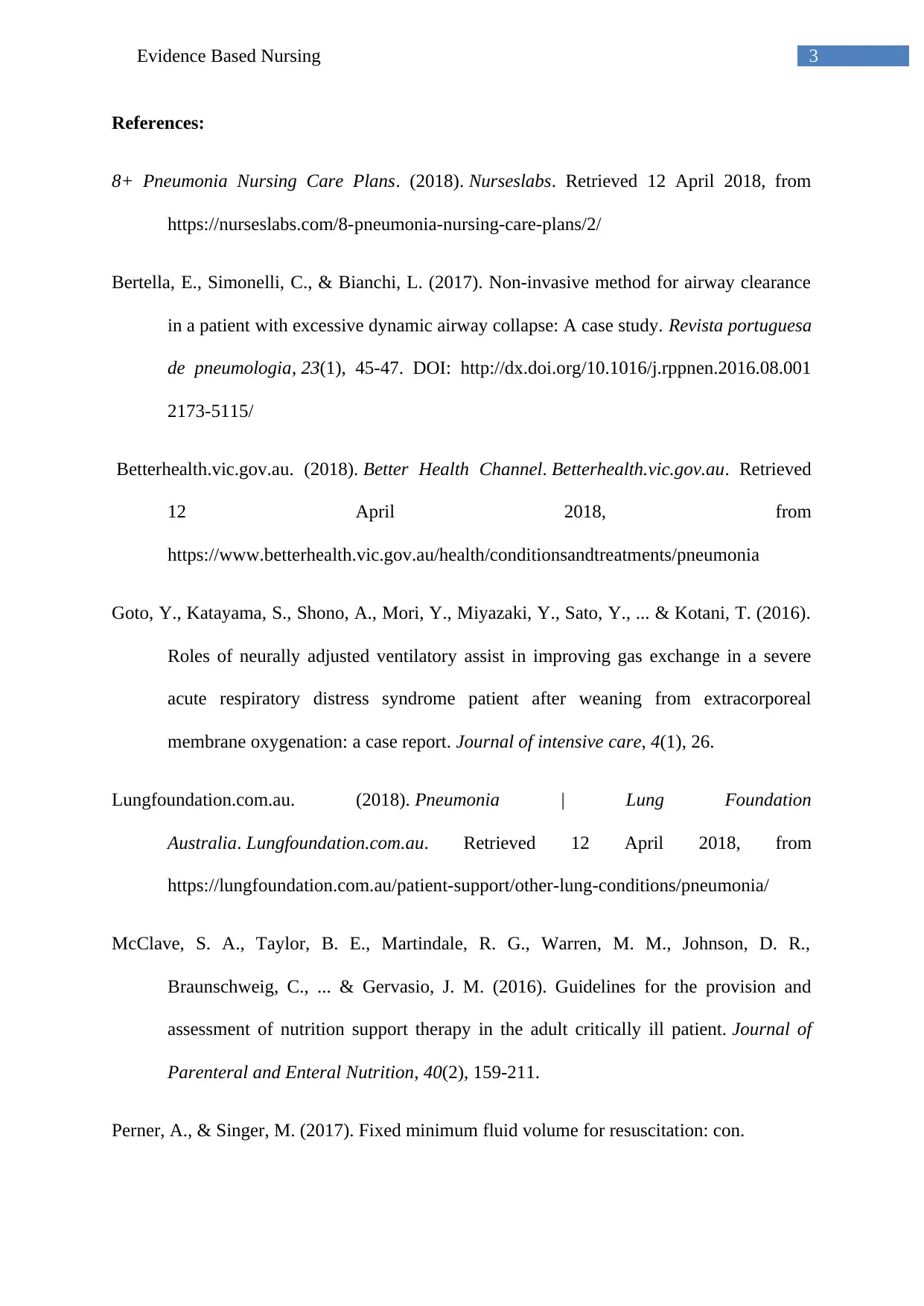
3Evidence Based Nursing
References:
8+ Pneumonia Nursing Care Plans. (2018). Nurseslabs. Retrieved 12 April 2018, from
https://nurseslabs.com/8-pneumonia-nursing-care-plans/2/
Bertella, E., Simonelli, C., & Bianchi, L. (2017). Non-invasive method for airway clearance
in a patient with excessive dynamic airway collapse: A case study. Revista portuguesa
de pneumologia, 23(1), 45-47. DOI: http://dx.doi.org/10.1016/j.rppnen.2016.08.001
2173-5115/
Betterhealth.vic.gov.au. (2018). Better Health Channel. Betterhealth.vic.gov.au. Retrieved
12 April 2018, from
https://www.betterhealth.vic.gov.au/health/conditionsandtreatments/pneumonia
Goto, Y., Katayama, S., Shono, A., Mori, Y., Miyazaki, Y., Sato, Y., ... & Kotani, T. (2016).
Roles of neurally adjusted ventilatory assist in improving gas exchange in a severe
acute respiratory distress syndrome patient after weaning from extracorporeal
membrane oxygenation: a case report. Journal of intensive care, 4(1), 26.
Lungfoundation.com.au. (2018). Pneumonia | Lung Foundation
Australia. Lungfoundation.com.au. Retrieved 12 April 2018, from
https://lungfoundation.com.au/patient-support/other-lung-conditions/pneumonia/
McClave, S. A., Taylor, B. E., Martindale, R. G., Warren, M. M., Johnson, D. R.,
Braunschweig, C., ... & Gervasio, J. M. (2016). Guidelines for the provision and
assessment of nutrition support therapy in the adult critically ill patient. Journal of
Parenteral and Enteral Nutrition, 40(2), 159-211.
Perner, A., & Singer, M. (2017). Fixed minimum fluid volume for resuscitation: con.
References:
8+ Pneumonia Nursing Care Plans. (2018). Nurseslabs. Retrieved 12 April 2018, from
https://nurseslabs.com/8-pneumonia-nursing-care-plans/2/
Bertella, E., Simonelli, C., & Bianchi, L. (2017). Non-invasive method for airway clearance
in a patient with excessive dynamic airway collapse: A case study. Revista portuguesa
de pneumologia, 23(1), 45-47. DOI: http://dx.doi.org/10.1016/j.rppnen.2016.08.001
2173-5115/
Betterhealth.vic.gov.au. (2018). Better Health Channel. Betterhealth.vic.gov.au. Retrieved
12 April 2018, from
https://www.betterhealth.vic.gov.au/health/conditionsandtreatments/pneumonia
Goto, Y., Katayama, S., Shono, A., Mori, Y., Miyazaki, Y., Sato, Y., ... & Kotani, T. (2016).
Roles of neurally adjusted ventilatory assist in improving gas exchange in a severe
acute respiratory distress syndrome patient after weaning from extracorporeal
membrane oxygenation: a case report. Journal of intensive care, 4(1), 26.
Lungfoundation.com.au. (2018). Pneumonia | Lung Foundation
Australia. Lungfoundation.com.au. Retrieved 12 April 2018, from
https://lungfoundation.com.au/patient-support/other-lung-conditions/pneumonia/
McClave, S. A., Taylor, B. E., Martindale, R. G., Warren, M. M., Johnson, D. R.,
Braunschweig, C., ... & Gervasio, J. M. (2016). Guidelines for the provision and
assessment of nutrition support therapy in the adult critically ill patient. Journal of
Parenteral and Enteral Nutrition, 40(2), 159-211.
Perner, A., & Singer, M. (2017). Fixed minimum fluid volume for resuscitation: con.
Paraphrase This Document
Need a fresh take? Get an instant paraphrase of this document with our AI Paraphraser
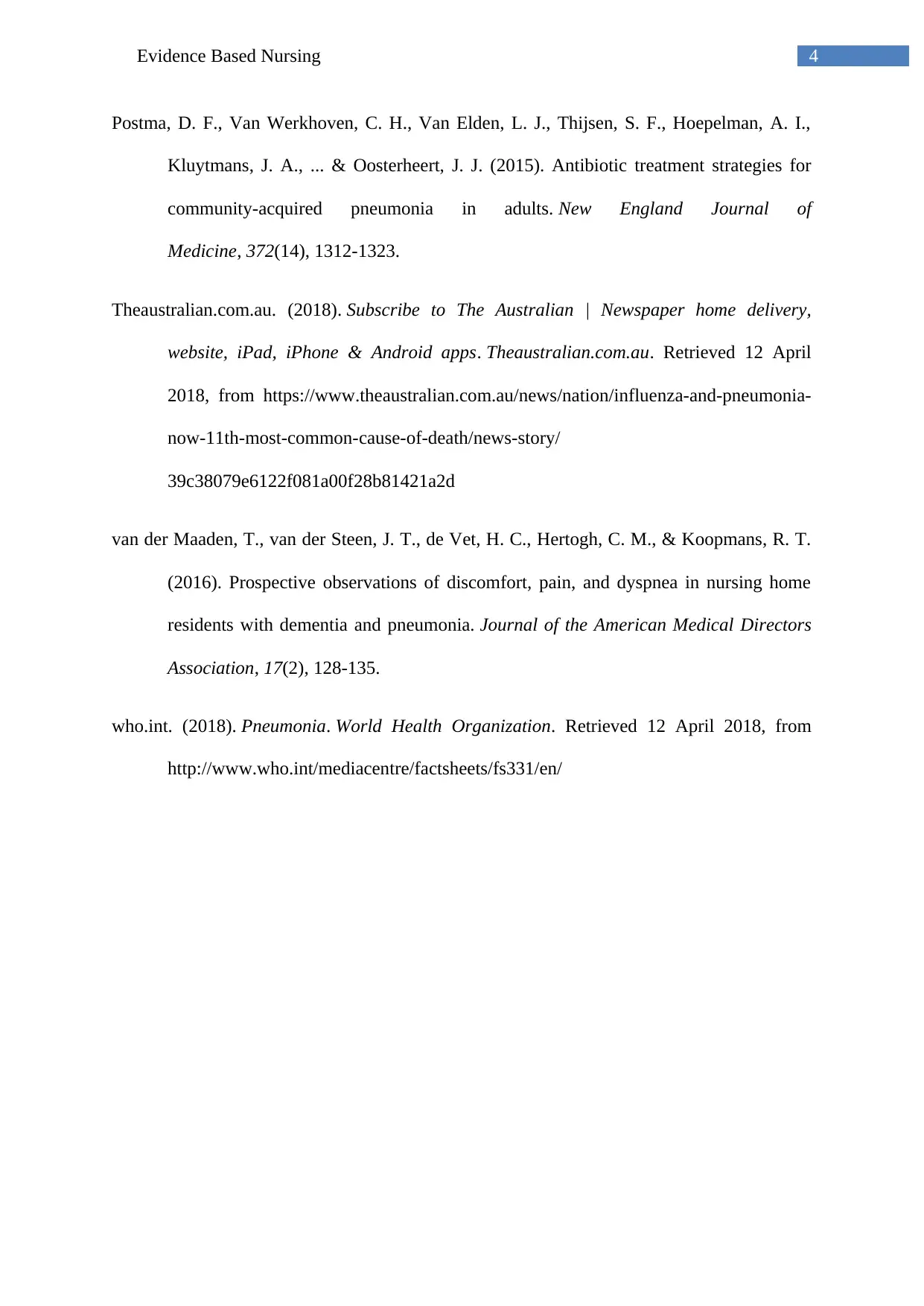
4Evidence Based Nursing
Postma, D. F., Van Werkhoven, C. H., Van Elden, L. J., Thijsen, S. F., Hoepelman, A. I.,
Kluytmans, J. A., ... & Oosterheert, J. J. (2015). Antibiotic treatment strategies for
community-acquired pneumonia in adults. New England Journal of
Medicine, 372(14), 1312-1323.
Theaustralian.com.au. (2018). Subscribe to The Australian | Newspaper home delivery,
website, iPad, iPhone & Android apps. Theaustralian.com.au. Retrieved 12 April
2018, from https://www.theaustralian.com.au/news/nation/influenza-and-pneumonia-
now-11th-most-common-cause-of-death/news-story/
39c38079e6122f081a00f28b81421a2d
van der Maaden, T., van der Steen, J. T., de Vet, H. C., Hertogh, C. M., & Koopmans, R. T.
(2016). Prospective observations of discomfort, pain, and dyspnea in nursing home
residents with dementia and pneumonia. Journal of the American Medical Directors
Association, 17(2), 128-135.
who.int. (2018). Pneumonia. World Health Organization. Retrieved 12 April 2018, from
http://www.who.int/mediacentre/factsheets/fs331/en/
Postma, D. F., Van Werkhoven, C. H., Van Elden, L. J., Thijsen, S. F., Hoepelman, A. I.,
Kluytmans, J. A., ... & Oosterheert, J. J. (2015). Antibiotic treatment strategies for
community-acquired pneumonia in adults. New England Journal of
Medicine, 372(14), 1312-1323.
Theaustralian.com.au. (2018). Subscribe to The Australian | Newspaper home delivery,
website, iPad, iPhone & Android apps. Theaustralian.com.au. Retrieved 12 April
2018, from https://www.theaustralian.com.au/news/nation/influenza-and-pneumonia-
now-11th-most-common-cause-of-death/news-story/
39c38079e6122f081a00f28b81421a2d
van der Maaden, T., van der Steen, J. T., de Vet, H. C., Hertogh, C. M., & Koopmans, R. T.
(2016). Prospective observations of discomfort, pain, and dyspnea in nursing home
residents with dementia and pneumonia. Journal of the American Medical Directors
Association, 17(2), 128-135.
who.int. (2018). Pneumonia. World Health Organization. Retrieved 12 April 2018, from
http://www.who.int/mediacentre/factsheets/fs331/en/

5Evidence Based Nursing
⊘ This is a preview!⊘
Do you want full access?
Subscribe today to unlock all pages.

Trusted by 1+ million students worldwide
1 out of 6
Related Documents
Your All-in-One AI-Powered Toolkit for Academic Success.
+13062052269
info@desklib.com
Available 24*7 on WhatsApp / Email
![[object Object]](/_next/static/media/star-bottom.7253800d.svg)
Unlock your academic potential
Copyright © 2020–2025 A2Z Services. All Rights Reserved. Developed and managed by ZUCOL.





